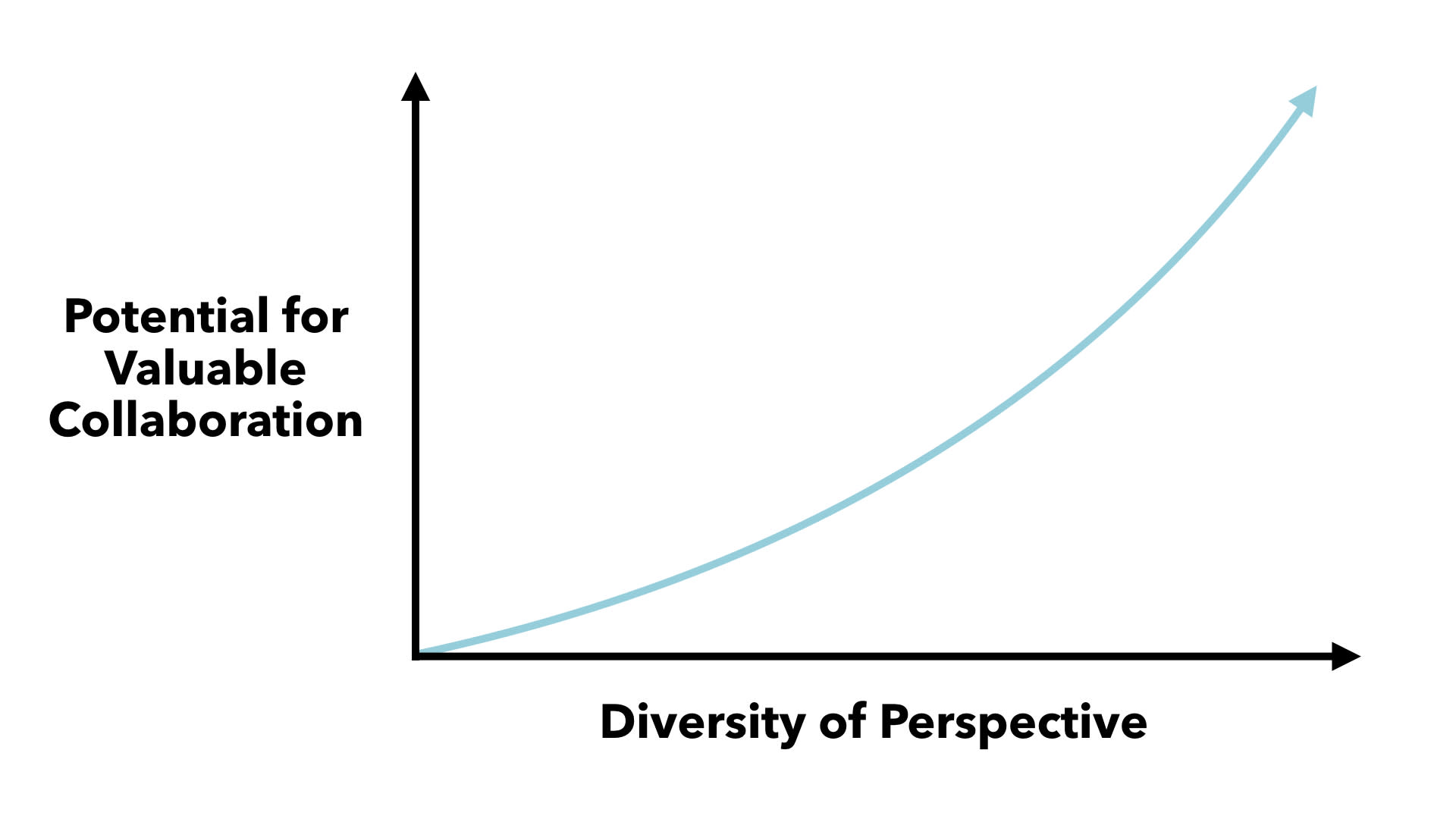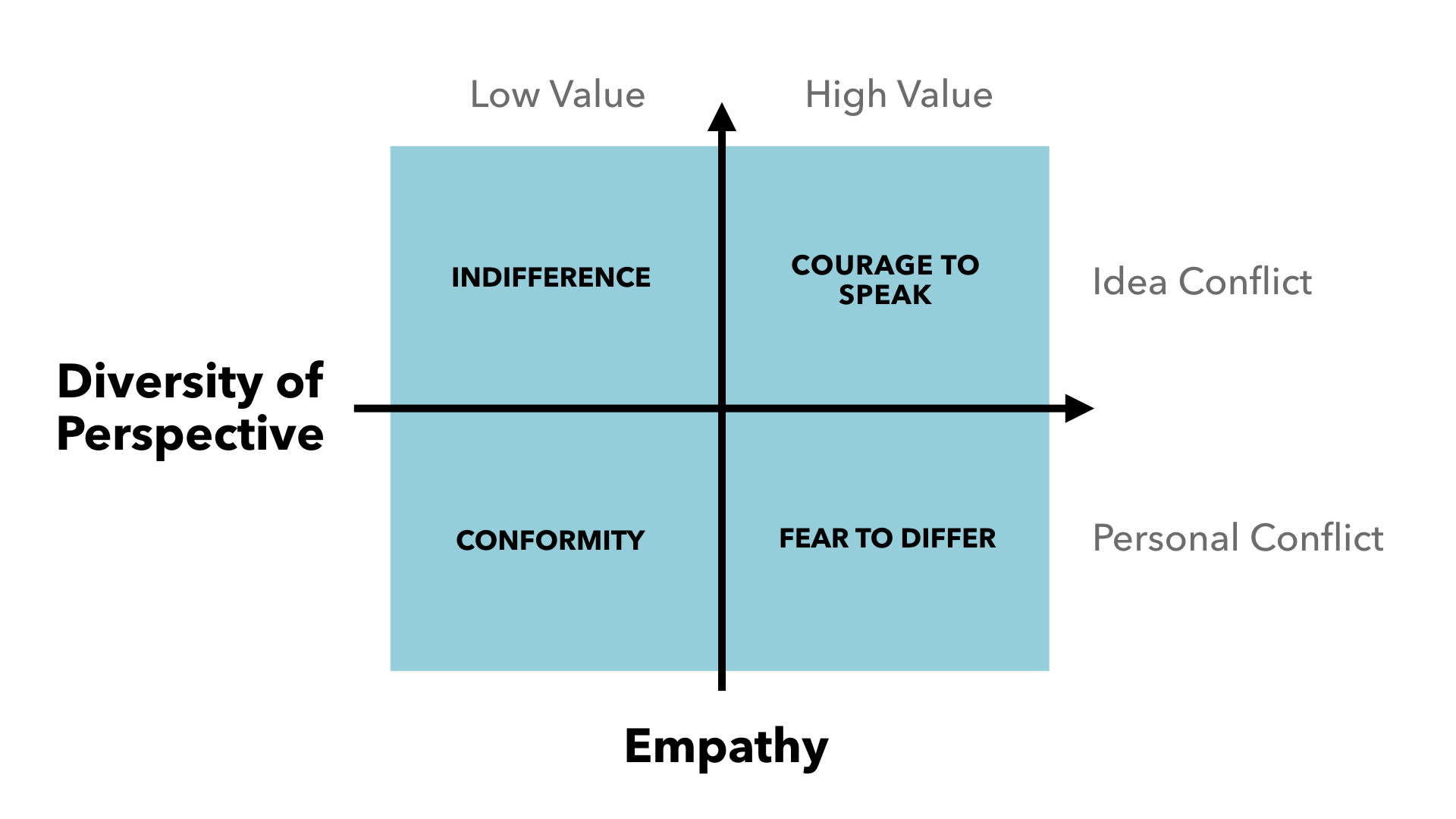It’s easy to mistake getting along for valuable collaboration. Many teams do it. I’ve done it. Maybe you’ve done it. So what do we do to encourage true collaboration in and among our teams? I believe there are two key ingredients to valuable collaboration: diversity of perspective and empathy.
Diversity of Perspective
Certainly, I’m not the first to say this. In fact, almost every study done on workplace collaboration that I could find comes to the same conclusion: having many unique perspectives leads to better solutions. If you put three people on a problem and they all have the same background or education, they will likely approach the problem in the same way. If you put three people with unique experiences or education on the problem, they will likely each have very different ideas of how to approach the challenge. This difference of ideas is what leads to unique solutions—it’s the friction needed to push us beyond the standard approach and into uncharted territory.

I’ve been using this graph as a way to illustrate the idea that as the diversity of perspective on our teams increases, the potential for valuable collaboration increases.
Empathy
Empathy is a key ingredient in valuable collaboration because it allows us to shift our focus from our interpersonal differences to the differences in our ideas. And remember, it’s that friction of ideas that helps us get to a truly valuable solution.
Here’s a concise way to put it: as the empathy on our teams increases, the ease of collaboration increases.

Empathy is the grease for a collaborative team. It’s what keeps things moving through the friction, and it’s what allows us to imagine how the decisions we make on a daily basis will impact those around us.
The Framework
Identifying diversity and empathy as two critical components allows us to consider a framework for valuable collaboration. When we put them together, we can evaluate where we are or where our team is operating. Check this out...

This gives us four potential quadrants to operate in. Because of the lack of diverse perspectives, both quadrants on the left side have a low potential for valuable collaboration. Conversely, the quadrants on the right side offer a high potential for valuable collaboration.
In the top left quadrant, we have what I call “Indifference.” There is not much conflict here (low potential for valuable collaboration), because there is not much diversity of perspective. Within teams in this quadrant, it’s okay to be different (high empathy!) but, unfortunately, nobody is. From here, you need to focus on getting more diverse perspectives into your organization. Remember, you need these perspectives in all aspects of your hierarchy, not just as juniors.
In the bottom left quadrant, we have “Conformity.” Because of the low empathy, people strongly question deviation from the norm. If you have a few folks with unique perspectives, you likely don’t know it. If you find yourself operating here, put some programs in place to start developing mutual respect and empathy among your team. This has to be where you start, otherwise you won’t be able to retain the great folks you find.
In the bottom right quadrant, we have “Fear to Differ.” There are diverse perspectives here, but nobody is willing to hear another side—it’s not worth sharing unique ideas because those ideas are simply shot down. While this quadrant could give the perception of being equally as valuable as “Courage to Speak,” it has major pitfalls for team happiness. This quadrant is almost impossible to maintain because an individual’s fear to differ will cause tension, animosity, and frustration. If you don’t move quickly enough, that frustration will cause people to leave until you find yourself in the “Conformity” quadrant. If you do happen to find yourself operating here, your immediate goal should be to help individuals shift their focus away from interpersonal differences and towards the differences in ideas. When we do this, we embrace a wide variety of perspectives as fertile ground for something beautiful to grow. This is, essentially, increasing empathy on your team, which will lead you directly into the top right quadrant...
In the top right quadrant, we have “Courage to Speak.” This is where dissenting views are encouraged. This is where we respect each other, despite our differences. This is where the best solutions emerge. Regardless of how diverse your team is, there is always room to improve! So don’t let up if you happen to be operating in this quadrant—continue to develop empathy in the people on your team and continue to be intentional about looking for folks with unique perspectives as you grow.
Back to Work
So what do we do now? How does this impact you and your team as you work? Here are a few things we can do to increase the diversity of our teams and help develop empathy in ourselves and our teammates.
Hire the Whole Person
If you happen to be someone who has a say in hiring, make sure you recognize that you can’t hire just a sliver of someone’s brain. Certainly, you want them to be able to do their job, but the way a person approaches a problem has as much to do with their life experience as it does with their skill in a specific discipline. Understanding and embracing this means we’ll invest in them as a whole person, not just their job title. For us, this means things like flexibility in schedule so our team can take care of life outside of work when they need to. Or a wellness budget to spend on things that help with them sleep better, eat well, and get stronger. All that other stuff people bring with them—the rest of their brain—is just as important as the sliver that does their job. It’s what creates their unique perspective. Once we accept this, we can find ways to develop them more holistically. Investing in ways beyond just their work-related skillset makes people better at life and better at their job.
Expose Disagreement, Don’t Hide It
So many organizations see disagreement as a bad thing, as something to avoid. Instead, we need to seek it out! You may have seen this quote from Dave Chappelle floating around the internet recently—it makes this point more eloquently than I ever could:
“Our culture has accepted two huge lies. The first is that if you disagree with someone’s lifestyle, you must fear or hate them. The second is that to love someone means you agree with everything they believe, say, or do. Both are nonsense. You don’t have to compromise convictions to be compassionate.” —Dave Chappelle
This statement is beautiful and it applies to the challenges we face when we manage to increase the amount of diverse perspectives represented on our teams. We need this kind of respect in our culture. We need to model it and encourage it.
We have a channel in Slack called #awesomeness. This is a place for folks to brag about each other, and it’s pretty fun to see our team call out the instances where someone goes above and beyond. As a leader in our organization, I’ve begun looking for opportunities to mention someone in that channel when I see them challenge the typical answer. In this way, we can encourage folks to speak up even if we don’t put a specific idea into practice.
Speak Less, Listen More
Sometimes your voice is the one drowning out those unique ideas. Be willing to speak a little less. In fact, be willing to ask those who are less outspoken to share what’s on their mind. Giving someone permission to offer a different perspective will go a long way toward your culture being willing to do the same.
I’ve got a big personality. Any of you that do as well can testify to the fact that it’s easy to share your ideas in a group setting. It’s taken me recognizing that not everyone is wired that way to be more intentional about keeping my mouth shut. Just creating that space in the conversation makes room for other folks to chime in.
Invest in Diverse Communities
On the topic of increasing diversity on our teams, there is no single answer. Leslie Miley shared this simple idea at Tech Inclusion last year:
“When you go to cities that have diverse populations you can hire people who are diverse because that’s who’s in the community. Then, those people will come back to your headquarters and hire people who look like them because that’s who’s in their networks.” —Leslie Miley
I see people starting new meetups, new events, new organizations and asking people to come to them. Then they wonder why nobody outside of their immediate circle attends. Before you start your next thing, do some work to see if there’s a diverse community near you working toward the same thing. Maybe your resources could really give their organization a needed boost. All you get in return is relationships, but that will prove more valuable than anything else you could invest in.
We’re trying to do this in as many ways as we can. Through partnerships with local groups that serve underrepresented populations, I’m starting to make some new friends. We have a long way to go, but I can tell this approach—supporting great organizations that are already connected—will be one we stick with for a long time.
Our Greatest Threat
I sincerely believe the greatest threat to valuable collaboration is the lack of diverse perspectives. Until we address this, our collaborations won’t be as strong as they could be, and they’ll be easy to confuse with just “getting along.” Certainly this is a topic that’s been discussed in our industry. Discussion is great, action is better. Let’s get to it.

